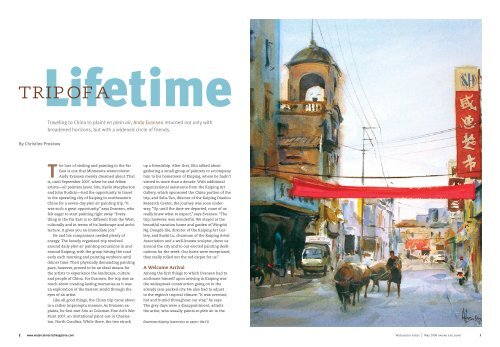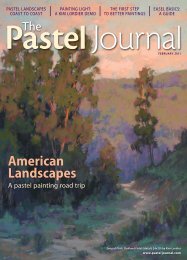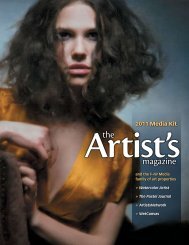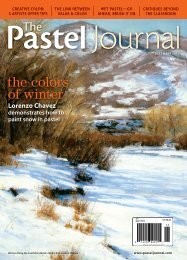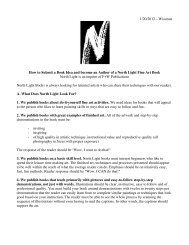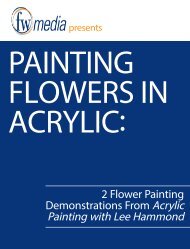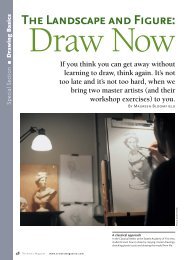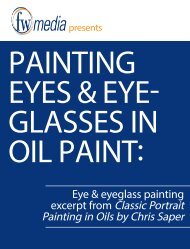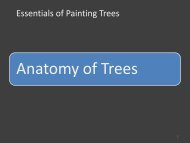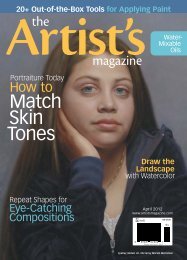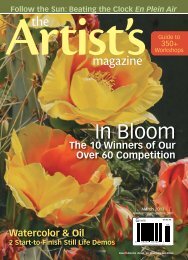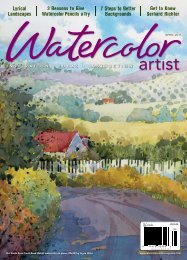You also want an ePaper? Increase the reach of your titles
YUMPU automatically turns print PDFs into web optimized ePapers that Google loves.
lifetimetrip of aTraveling to China to plaint en plein air, <strong>Andy</strong> <strong>Evansen</strong> returned not only withbroadened horizons, but with a widened circle of friends.By Christine ProskowThe lure of visiting and painting in the FarEast is one that Minnesota watercolorist<strong>Andy</strong> <strong>Evansen</strong> merely dreamed about. Thatis, until September 2007, when he and fellowartists—oil painters Jason Situ, Kevin Macphersonand John Budicin—had the opportunity to travelto the sprawling city of Kaiping in southeasternChina for a seven-day plein air painting trip. “Itwas such a great opportunity,” says <strong>Evansen</strong>, whofelt eager to start painting right away. “Everythingin the Far East is so different from the West,culturally and in terms of its landscape and architecture.It gives you an immediate jolt.”He and his companions needed plenty ofenergy: The loosely organized trip revolvedaround daily plein air painting excursions in andaround Kaiping, with the group hitting the roadearly each morning and painting outdoors untildinner time. Their physically demanding paintingpace, however, proved to be an ideal means forthe artists to experience the landscape, cultureand people of China. For <strong>Evansen</strong>, the trip was asmuch about creating lasting memories as it wasan exploration of the Eastern world through theeyes of an artist.Like all good things, the China trip came aboutin a rather impromptu manner. As <strong>Evansen</strong> explains,he first met Situ at Coleman Fine Art’s WetPaint 2007, an invitational paint-out in Charleston,North Carolina. While there, the two struckup a friendship. After that, Situ talked aboutgathering a small group of painters to accompanyhim to his hometown of Kaiping, where he hadn’tvisited in more than a decade. With additionalorganizational assistance from the Kaiping ArtGallery, which sponsored the China portion of thetrip, and Selia Tan, director of the Kaiping DiaolouResearch Center, the journey was soon underway.“Up until the time we departed, none of usreally knew what to expect,” says <strong>Evansen</strong>. “Thetrip, however, was wonderful. We stayed at thebeautiful vacation home and garden of WingchiNg. Dongda Xie, director of the Kaiping Art Gallery,and Bushi Lu, chairman of the Kaiping ArtistAssociation and a well-known sculptor, drove usaround the city and to our elected painting destinationsfor the week. Our hosts were exceptional;they really rolled out the red carpet for us.”A Welcome ArrivalAmong the first things to which <strong>Evansen</strong> had toacclimate himself upon arriving in Kaiping wasthe widespread construction going on in thealready jam-packed city. He also had to adjustto the region’s tropical climate. “It was overcast,hot and humid throughout our stay,” he says.The grey days were a disappointment, admitsthe artist, who usually paints en plein air in theDowntown Kaiping (watercolor on paper; 18x13)www.watercolorartistmagazine.comwatercolor Artist | May 2008 online exclusive
Wingchi Ng’s garden Goose Shack reference photo Goose Shack (watercolor on paper; 10x14) Diaolou reference photoearly morning or late afternoon sunshine fordramatic lighting effects. Yet what the weatherseemed to lack, the subject matter more thanmade up for.“Our first morning in China, we had breakfastwith our hosts in Mr. Ng’s garden [see photoabove] before they drove us around Kaiping andto some of the outlying villages to give us a feelfor the environment,” he says. “From that introductorytour, we decided to paint in Zili villagethe following day, our first full painting day, andended up spending a couple of days there. In all,we visited four or five of Kaiping’s surroundingvillages, including Chikan village where Jasongrew up.”<strong>Evansen</strong>’s paintings of Zili village reveal alush, green landscape. “The villages are verysmall. We didn’t have to drive far outside thecity before the landscape transformed intopicturesque countryside with mountains in thedistance,” he says. “Going into the village feltlike stepping back in time. It marked just oneinstance of a frequently stark contrast betweenthe old and the new.”Emphasizing that sense of the old were thediaolou (see photo on page 5)—unusual towerlikestructures—unique to this region of China.“The diaolou were built beginning in the 15thand 16th centuries for housing, and for protectionof the citizens from bandits and extensiveflooding,” the artist says. “Today the buildings[of which 1,800 still remain] are preserved,though you can go into them. Some still haverelics of exquisite shrines with gold leaf andstatues.” To capture a different perspective ofthe landscape, one that offers a glimpse of moreof the area’s pastoral setting, <strong>Evansen</strong> painteda scene from atop one of these multi-storiedstructures. (See View Atop Diaolou, on page 5.)People WatchingIf the villages were quiet and remote, the artistsfound painting in Kaiping (a city of approximately650,000) to be highly stimulating. Thecity streets, riverfront and constant action oflocals going about their daily lives were an endlesssource of fascinating subject matter. Yet tothe Chinese passersby, it was <strong>Evansen</strong> and hisfellow artists who made for a captivating sourceof interest; wherever they set up their easels,they attracted a crowd. “When we painted inthe village, a few of the villagers would stop byto see what we were doing,” he says. “Paintingin Kaiping, however, I’d soon have 50 or morepeople crowded all around me—some evenstanding directly in front of my view. There waslittle sense of personal space there. Often, atleast one person would videotape the wholeprocess. When I finished a painting, everyonewould applaud and then they’d all pull out theircameras to have their picture taken with me.”This kind of intense interaction with thepublic was at its height when <strong>Evansen</strong> paintedDowntown Kaiping (on page 3). “I was drawn tothe old clock tower with the bright red banneracross the street. I had a huge crowd around methat day; people just kept coming and coming,”he says. “Then a truck came and parked rightalongside me, so I had to pick up all my gear.Some of the onlookers helped me reposition View Atop Diaolou (watercolor on paper; 10x14)www.watercolorartistmagazine.comwatercolor Artist | May 2008 online exclusive
on very thin paper,” says the artist. A foam boardbacking, Black Velvet round brushes in sizes 12and 16, Winsor & Newton watercolors and afull-sized John Pike palette rounded out hispainting gear. “Most of my paintings took aboutan hour to paint; you don’t have much moretime than that en plein air. I try to finish thepainting in three washes by getting down thewhites, knocking in all my middle tones andthen adding my darks to accent and define thepiece. And that’s it.”Although <strong>Evansen</strong> worked directly from eachscene, such as the one depicted in Fishing Nets(on page 9), he always began by taking a digitalphotograph (on page 8). “Often I’ll do a largerstudio painting of the image, using both myplein air painting and the corresponding photoas reference,” he says. Yet his camera served theplein air painting process on location as well. Heused his camera’s viewfinder to crop the sceneand referred to the display screen to quicklydraw structural composition lines on his paperbefore closing up his camera to paint. Thetranslucent fishing nets with the old houseboatsand mountains in the distance attracted<strong>Evansen</strong> to this particular sight. “I liked theunique shapes of the boats,” he says. “I alwayslook for interesting shapes—I don’t necessarilygo for the prettiest scene.” By squinting athis subject, the artist painted the large shapesMidday Umbrellas (watercolor on paper; 14x19)my supplies several feet forward along thesidewalk. Everyone was so encouraging andobliging.” The original plein air painting of thatscene, which <strong>Evansen</strong> subsequently donated tothe Kaiping Art Gallery, didn’t include the manwith the ox. “He came around the corner whileI was painting. I stopped everything, pulled outmy camera and snapped a photo of him as thecrowd cheered me on. Later, when I re-createdthe image in my studio, I inserted the manand the ox,” he says. “The crowds in Kaipingwere quite phenomenal because of the energythey gave. A few times, I found myself gettingdistracted and working too fast, but overall thatenergy seemed to help the paintings vibrate.”A more regular presence among the artistswere the 10 or 15 students from the KaipingArt Center who observed the group of travelingartists as part of its sponsorship. “We hadso much fun,” says <strong>Evansen</strong>. “They’d find outwhere we were setting up in the morning andthen meet us at our location. Despite the largelanguage barrier, <strong>Evansen</strong> and the studentsmanaged to communicate. “We laughed a lot,even though often I didn’t know what about!One or two students could speak broken English,but for the most part I was surroundedby all this chatter that I couldn’t understand.As the week went on, it was really hard to saygoodbye,” he says.Getting In the GrooveOne thing that interested the art center studentswere <strong>Evansen</strong>’s supplies, which he pareddown for the trip. “They kept checking out mySoltec easel and Arches 300-lb. cold-pressedwatercolor paper. They couldn’t believe howthick the paper was. They paint, in comparison,Street Vendor reference photo (above)Street Vendor (at left; watercolor on paper;14x10)www.watercolorartistmagazine.comwatercolor Artist | May 2008 online exclusive
first, simultaneously allowing colors to mixand merge on his paper. “I don’t get too boggeddown with details to begin with—those cancome later. Generally, the painting comes togetheron its own if you do that.”Midday Umbrellas (on page 6), with its colorfulumbrellas and glistening rain-soaked street,was a subject that caught <strong>Evansen</strong>’s eye inthe moment. “We were just driving into thecity when it started to rain. Suddenly a sea ofumbrellas popped open, almost in unison. Weall shouted, ‘Stop the car!’ ” The artists hoppedout and began a picture-taking frenzy, whichbecame the basis for this studio painting.“Nothing stopped; everyonekept going about their business.Even the bicyclists keptriding with protective raincoats thrown about them. Itwas so pretty,” he says. A shortwhile later, <strong>Evansen</strong> paintedStreet Vendor (on page 7) as hestood under an awning to keepfrom getting wet in the rain.“That was later in the week,so we were all getting in thegroove by then. We decidedwhat we should do: either takea break or find a sheltered spotto paint,” he says. “I eliminatedprobably 100 people from thatscene because I wanted to focus on the vendor.My goal is to keep the painting loose and tocreate that sense of movement, or whatever’sgoing on in a scene.”Winding DownIn the evenings, the artists relaxed and wereentertained by people in the community. Onenight, they visited a karaoke bar. On another,they were treated to an informal calligraphydemonstration at the art center garden, wherea couple of local artists shared their techniques.“By pushing hard on a large calligraphybrush, they’d make these big, bold shapes,” saysFishing Nets reference photo Fishing Nets (watercolor on paper; 10x14)Group at Hot Springs<strong>Evansen</strong> (at left) donating a painting to the gallery<strong>Evansen</strong>. “Then they’d switch to a smaller brushand create delicate writing. It was wonderful towatch.” The artists in <strong>Evansen</strong>’s group also triedtheir hand at calligraphy, using the demonstrators’samples as guides. “The calligraphy brushesare similar to round watercolor brushes, so Ifelt comfortable with them,” he says. As a finaltouch to the calligraphic design, special stampswere used around the image—one that identifiedthe calligrapher’s signature, others carvedwith happy words. Each artist later receivedhis own stamp, carved with his signature inChinese.The week culminated with a special receptionfor the artists at the Kaiping Art Gallery.“The place was packed. The Chinese mediawere there and the director of cultural affairspresented each of us with gifts and a plaque ofappreciation. We brought our paintings so thateveryone could look at them,” <strong>Evansen</strong> says.The artists, who each donated paintings to thegallery and to Mr. Ng, also got to see some of thestudents’ work. “I was amazed at their talent.They take their art, and especially watercolor,very seriously,” he says. Overall, <strong>Evansen</strong>’s visitto China went beyond anything he had anticipated.“It was the trip of a lifetime. The peoplewere so generous and kind, and many friendshipswere made in the course of the week. Oneof the sentiments painted on the night of thecalligraphy demonstration translated to, ‘usethe painting to make friends.’ That seemed tosum up our trip very nicely.”christine prosKow is an artist and writer living in ThousandOaks, California.www.watercolorartistmagazine.comwatercolor Artist | May 2008 online exclusive


